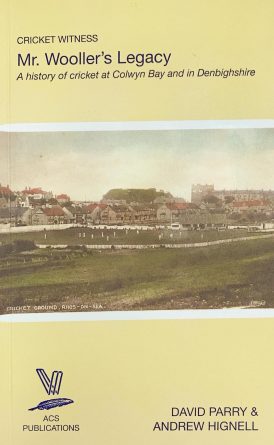Mr Wooller’s Legacy: A History of Cricket at Colwyn Bay and in Denbighshire
Martin Chandler |Published: 2023
Pages: 175
Author: Parry, David and Hignell, Andrew
Publisher: ACS
Rating: 3.5 stars

I have good news, and I have bad news as far as this one is concerned, a February release from the ACS. The good is that the book, even if its title and sub-title suggest it may have limited appeal, is a very good one. The bad is that while that same title and sub-title do not suggest a book that is going to sell so well it becomes out of print within a month, it has!
In the circumstances I did briefly pause to consider whether I should review the book at all, but all things considered I have never been one for letting that consideration get in the way of giving my views on a book I have enjoyed reading, and in any event maybe a bit more interest will persuade the ACS to run off a few more copies.*
Denbighshire is a county in North Wales and, therefore, around three hours or 150 miles from Glamorgan, the only First Class county in the Principality. Nonetheless Glamorgan do, and have since 1990, played a game or two at Colwyn Bay virtually every season, so there will be interest from Welsh cricket enthusiasts generally, as well as those in the North of the country, which may explain why the book has sold out so quickly.
As befits any self-respecting history this one starts at the beginning, back in the 1820s, although initially the game spread slowly in North Wales. As the years passed one particularly interesting development came towards the end of the 19th century, with the formation of the first black cricket team in Wales, and probably in the UK as well.
The central theme of the book surrounds the formation of the Colwyn Bay club in 1923, thus the book is published to coincide with its centenary season, and the arrival of the Wooller family and the role they played in the club’s development.
Wilf Wooller is a noted figure in Welsh sport. A Rugby Union international and a rumbustious all-rounder who led Glamorgan for fourteen summers after World War Two. His father, Wilf Snr, was the driving force behind the Colwyn Bay story, although Wilf Jnr plays a role in that story as well.
The one thing I did know about Denbighshire cricket before I opened Mr Wooller’s Legacy was that the county had, briefly, appeared in the Minor Counties Championship in the 1930s. I knew also that they had had a torrid time, losing almost all the games they played over four summers and not winning a single one. The one quality player they had was Wilf Jnr, and in one game he played alongside three of his brothers, although none of Jack, Roy or Gerald Wooller were in the same class as Wilf Jnr.
The chapter that covered the minor county years was, when I opened the book, the part of the story that I really wanted to read and I was not disappointed. But equally interesting were the events that followed from the then retired Wilf Jnr bringing Glamorgan to Colwyn Bay for a Championship fixture in 1966, following which the county returned each year up to 1974 before that hiatus until 1990, so there is a good deal of coverage of the First Class game as well as the club game.
So Mr Wooller’s Legacy: A History of Cricket at Colwyn Bay and in Denbighshire is not as ‘niche’ as it might appear at first blush and, well written, well illustrated and well designed it is certainly recommended reading for anyone with an interest in Welsh cricket.
*The answer to that one is ‘not yet’, but I do have some good news in that copies can currently be had via the CC4 Museum of Welsh Cricket (museum@glamorgancricket.co.uk) or Roger Page (rpcricketbooks@iprimus.com.au) in Australia






Leave a comment